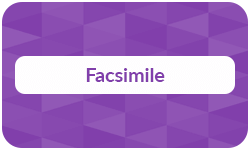
In printing terms, a facsimile refers to an exact copy or reproduction of a document, often transmitted electronically. While traditionally associated with fax machines, modern facsimile technology allows for quick and efficient document sharing across industries. This guide explores today’s communication systems’ history, applications, and benefits, highlighting their importance in both digital and physical formats.
Inhaltsverzeichnis
Definition: Facsimile
A facsimile (from the Latin fac simile, meaning “to make alike”) is an exact reproduction of an original manuscript, artwork, or object, crafted to be as true to the source as possible. Unlike other forms of reproduction, a facsimile strives to replicate the original in scale, color, condition, and other material qualities, offering an accurate copy of all pages or components. For medieval manuscripts and books, this means a complete reproduction — an incomplete copy would be considered a “partial facsimile.”
Some expensive facsimiles are created for collectors, offering high-quality, detailed reproductions.
Note: The term “fax” is short for facsimile, but modern faxes do not match the precision and detail of a true facsimile. With desktop printers and modern digital tools, creating a convincing facsimile has become easier, though true-to-source reproduction remains a specialized skill, especially in the art of facsimile.
Copy and print from CAN$0.14
- High-quality copies & prints for any project
- Vibrant color prints or sharp black & white prints
- Online copy and print services delivered straight to your door
Learn more!
History
The art of facsimile has long been tied to advances in printmaking and reproduction. Early efforts focused on reproducing maps, such as the Abraham Ortelius map from 1598, though these lacked the exact precision expected today. Early facsimile efforts were not always perfect, often resulting in weak facsimiles that didn’t capture the original’s detail.
In the 18th century, techniques like lithography and aquatint allowed for more accurate facsimiles of drawings and illuminated manuscripts, enabling scholars to study original manuscripts remotely. These more detailed copies were often used for research, as they could provide an accessible version of biblical manuscripts and other historically important texts.
Before digital technology, devices like the philograph, photostat, and hectograph were used to create facsimiles. With modern tools such as scanners, computers, and desktop printers, facsimiles can now be easily produced and shared.
Philograph
A device used to create facsimiles by tracing an original through a transparent surface.
Photostat
An early photographic process that produces facsimile copies of documents or images.
Hectograph
A printing process that transfers ink from a gelatin surface to paper, creating multiple copies.
Today, so-called digital facsimiles are common — high-quality reproductions stored online, often in manuscript repositories. These digital facsimiles serve as vital resources for researchers and historians, offering access without handling fragile originals. For example, translations of facsimile manuscripts are increasingly available for global study, providing broader access to rare documents.
Applications
Facsimiles are used across various fields to transmit, preserve, and authenticate important documents. Below are key areas where facsimiles play a crucial role.
Facsimiles have historically helped individuals send personal documents and preserve originals.
Facsimiles allow scholars to study rare or fragile materials without risking damage.
Facsimiles remain a trusted tool for quick and secure transmission of official business documents.
In legal settings, facsimiles are accepted for submitting time-sensitive documents.
Technology
Facsimile technology has evolved significantly, starting with traditional fax machines that transmit scanned documents over telephone lines. This process converts physical pages into electronic signals sent to a receiving fax machine, which then recreates the document.
Modern facsimile methods use digital tools like scanners and PDF transmission, allowing documents to be sent via email or online fax services. These digital facsimiles offer improved speed, quality, and ease of sharing compared to older technologies.
PDF printing at BachelorPrint from CAN$0.14
- Upload your files & order printed PDFs in minutes
- Secure online PDF printing service with reliable delivery
- High-quality prints from any PDF, including reports & more
Learn more!
Benefits & challenges
Facsimile technology offers several advantages but also faces some limitations, especially with the rise of newer communication methods.
Benefits
- Facilitates remote signing and swift approval processes
- Compatible with a wide range of document types and formats
- Provides a physical or digital record of transmission for verification
Challenges
- Limited by fax machine availability in some regions or organizations
- Fax machines and transmission lines can be prone to technical errors
- Concerns with sensitive information being transmitted over unsecured lines
FAQs
A facsimile is an exact reproduction or copy of a document, artwork, or object, created to replicate the original as closely as possible.
While “fax” is short for facsimile, the two terms are not exactly the same. As facsimile refers to a high-quality copy of a document, while a fax usually refers to a document sent via telephone line, often with lower quality.
A facsimile is an exact copy made to replicate the original, often preserving all material qualities. A replica, on the other hand, is a copy made to look similar but may not fully match the original in size, color, or detail.
No, a facsimile is a reproduction of a document, artwork, or object, while a signature is a unique mark or name written by an individual.
Some synonyms for facsimiles include copies, reproductions, duplicates, replicas, and reprints.